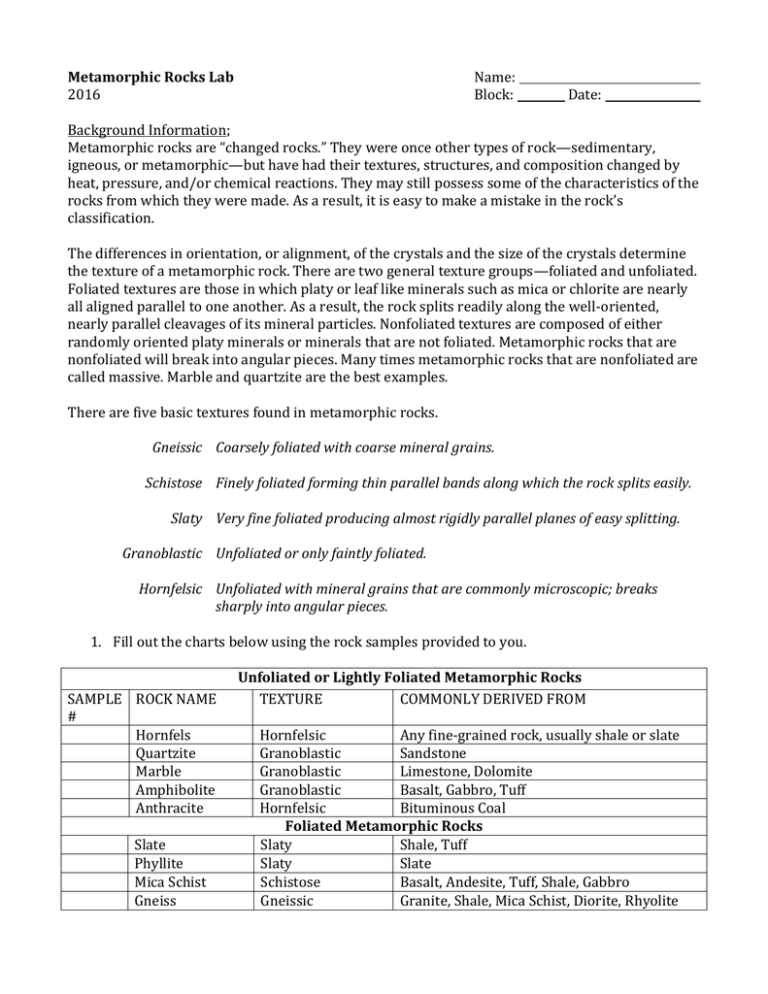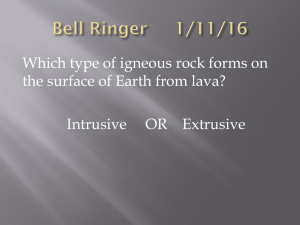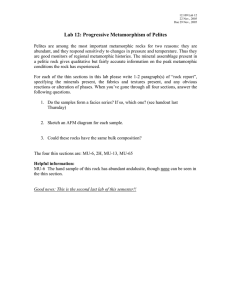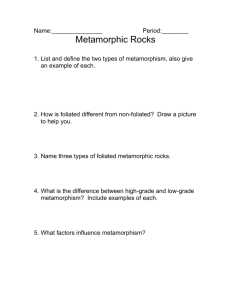Metamorphic Rocks Lab Name: 2016
advertisement

Metamorphic Rocks Lab 2016 Name: Block: Date: Background Information; Metamorphic rocks are “changed rocks.” They were once other types of rock—sedimentary, igneous, or metamorphic—but have had their textures, structures, and composition changed by heat, pressure, and/or chemical reactions. They may still possess some of the characteristics of the rocks from which they were made. As a result, it is easy to make a mistake in the rock’s classification. The differences in orientation, or alignment, of the crystals and the size of the crystals determine the texture of a metamorphic rock. There are two general texture groups—foliated and unfoliated. Foliated textures are those in which platy or leaf like minerals such as mica or chlorite are nearly all aligned parallel to one another. As a result, the rock splits readily along the well-oriented, nearly parallel cleavages of its mineral particles. Nonfoliated textures are composed of either randomly oriented platy minerals or minerals that are not foliated. Metamorphic rocks that are nonfoliated will break into angular pieces. Many times metamorphic rocks that are nonfoliated are called massive. Marble and quartzite are the best examples. There are five basic textures found in metamorphic rocks. Gneissic Coarsely foliated with coarse mineral grains. Schistose Finely foliated forming thin parallel bands along which the rock splits easily. Slaty Very fine foliated producing almost rigidly parallel planes of easy splitting. Granoblastic Unfoliated or only faintly foliated. Hornfelsic Unfoliated with mineral grains that are commonly microscopic; breaks sharply into angular pieces. 1. Fill out the charts below using the rock samples provided to you. SAMPLE ROCK NAME # Hornfels Quartzite Marble Amphibolite Anthracite Slate Phyllite Mica Schist Gneiss Unfoliated or Lightly Foliated Metamorphic Rocks TEXTURE COMMONLY DERIVED FROM Hornfelsic Any fine-grained rock, usually shale or slate Granoblastic Sandstone Granoblastic Limestone, Dolomite Granoblastic Basalt, Gabbro, Tuff Hornfelsic Bituminous Coal Foliated Metamorphic Rocks Slaty Shale, Tuff Slaty Slate Schistose Basalt, Andesite, Tuff, Shale, Gabbro Gneissic Granite, Shale, Mica Schist, Diorite, Rhyolite 2. What two things determine the texture of a metamorphic rock? 3. Describe the two general textures of metamorphic rocks. 4. Metamorphic rocks that are non-foliated are called 5. In the boxes below draw the parent rock and the metamorphic rock. Granite Gneiss Sandstone Quartzite Gabbro Schist . 6. In what ways are Granite and Gneiss similar? How are they different? 7. What happened to Sandstone’s stratification as it was changed to marble? 8. Compare and contrast Gabbro and Schist. 9. The classification of metamorphic rocks is based primarily on and composition. 10. What metamorphic rocks would result from the metamorphism of the following? a. Limestone b. Sandstone c. Granite d. Shale e. Bituminous Coal 11. For each of the following descriptions, indicate the metamorphic rock. a. Granoblastic, find to coarse-grained, composed mainly of calcite, dolomite or both. b. Very fine grained, exceptionally well-foliated rock. c. Coarse-grained rock with distinct layers or lenses of different minerals; among the most plentiful of metamorphic rocks d. Very hard, sugary-textured granoblastic rock; very widely distributed; made of interlocking quartz grains e. Hard, unfoliated, very fine-grained rock that breaks into angular pieces; very shiny 12. Use the chart below to answer the remainder of the questions. a. What is the relationship between rock temperature and depth below the surface? b. At a depth of 10 km, what would the temperature be? c. Between 0 and 10 km, how many degrees per kilometer does the temperature increase? d. Which metamorphic rock shown forms at the highest temperature? e. Through what general temperature range would you expect schist to form? f. How many kilometers below the surface does gneiss occur? g. As depth increases, what happens to the temperature at which rock melts? h. Suppose you knew that a certain metamorphic rock begins to form at 300° C. How many kilometers below the surface might this rock temperature occur? i. How far beneath the surface does shale metamorphose to slate? j. Metasomatism is described as a process by which metamorphic rocks may gradually change to igneous rock. At which temperature does metasomatism begin?






